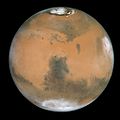Berkas:Mars and Syrtis Major - GPN-2000-000923.jpg

Ukuran pratayang ini: 600 × 600 piksel. Resolusi lainnya: 240 × 240 piksel | 480 × 480 piksel | 1.023 × 1.023 piksel.
Ukuran asli (1.023 × 1.023 piksel, ukuran berkas: 104 KB, tipe MIME: image/jpeg)
Riwayat berkas
Klik pada tanggal/waktu untuk melihat berkas ini pada saat tersebut.
| Tanggal/Waktu | Miniatur | Dimensi | Pengguna | Komentar | |
|---|---|---|---|---|---|
| terkini | 17 Juni 2012 22.57 |  | 1.023 × 1.023 (104 KB) | Tomruen | {{Information |Description ={{en|1=Mars Near Opposition 1995-2005: 1999 }} |Source =Replace with 2005 release: http://hubblesite.org/newscenter/archive/releases/solar%20system/mars/2005/34/image/h/ |Author =NASA |Date =2005... |
| 9 April 2009 00.52 |  | 800 × 800 (227 KB) | BotMultichillT | {{Information |Description={{en|1=Taking advantage of Mars's closest approach to Earth in eight years, astronomers using NASA's Hubble Space Telescope have taken the space-based observatory's sharpest views yet of the Red Planet. The telescope's Wide Fi |
Penggunaan berkas
Halaman berikut menggunakan berkas ini:
Penggunaan berkas global
Wiki lain berikut menggunakan berkas ini:
- Penggunaan pada ar.wikipedia.org
- Penggunaan pada ca.wikipedia.org
- Penggunaan pada en.wikipedia.org
- Portal:Technology/Selected articles
- Portal:Technology/Selected articles/38
- History of Mars observation
- Portal:Outer space/Selected article
- Glossary of astronomy
- Portal:Outer space/Selected article/31
- Wikipedia:Today's featured article/January 2013
- Wikipedia:Today's featured article/January 8, 2013
- Wikipedia:Main Page history/2013 January 8
- Penggunaan pada es.wikipedia.org
- Penggunaan pada fi.wikipedia.org
- Penggunaan pada fr.wikipedia.org
- Penggunaan pada he.wikipedia.org
- Penggunaan pada ja.wikipedia.org
- Penggunaan pada mwl.wikipedia.org
- Penggunaan pada os.wikipedia.org
- Penggunaan pada pt.wikipedia.org
- Penggunaan pada ru.wikipedia.org
- Penggunaan pada uk.wikipedia.org
- Penggunaan pada ur.wikipedia.org
- Penggunaan pada zh.wikipedia.org

